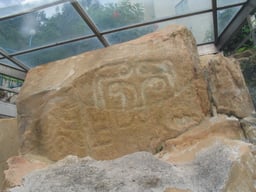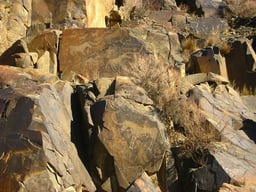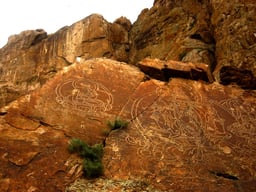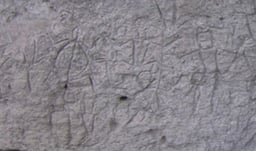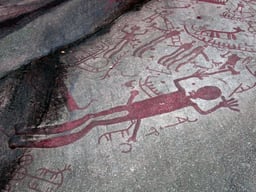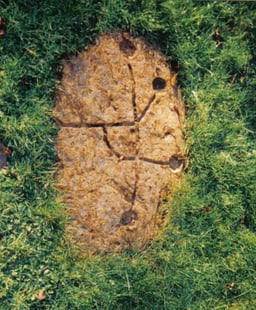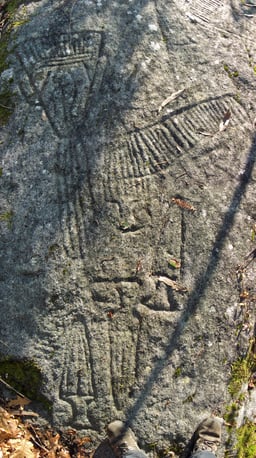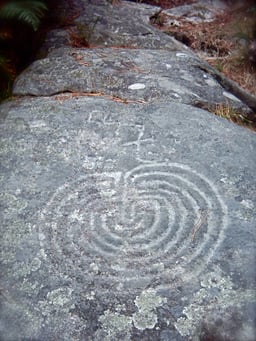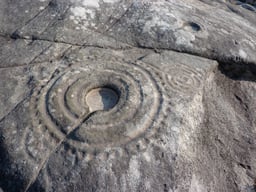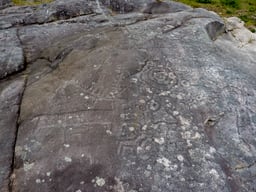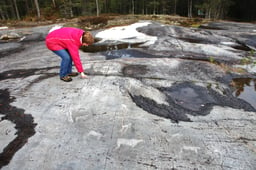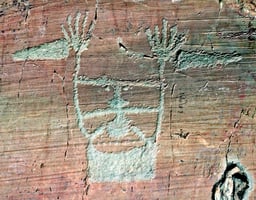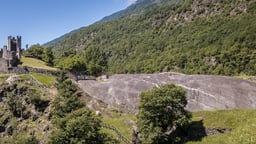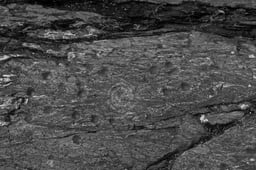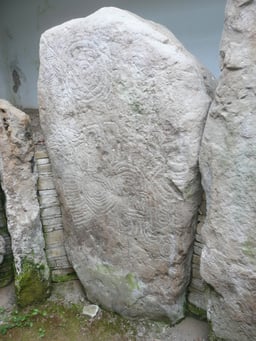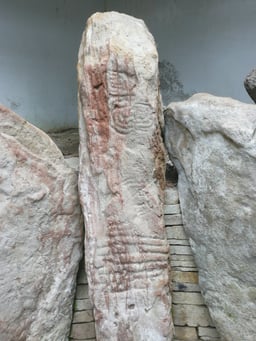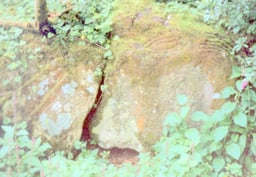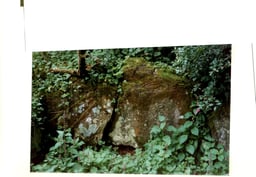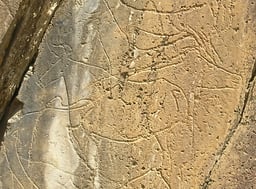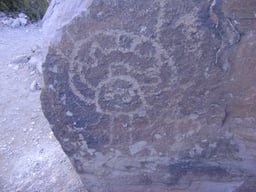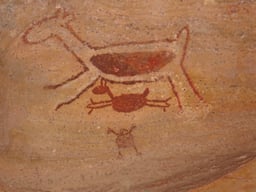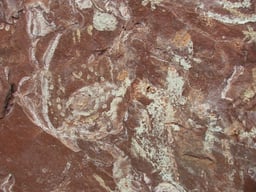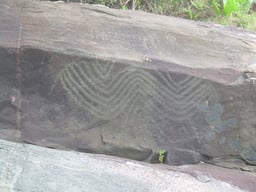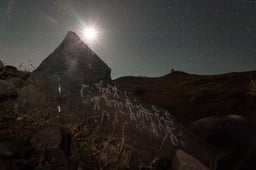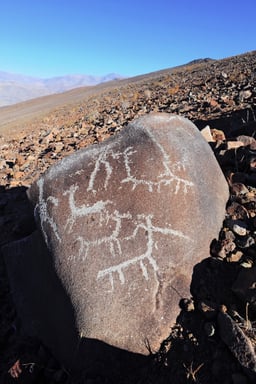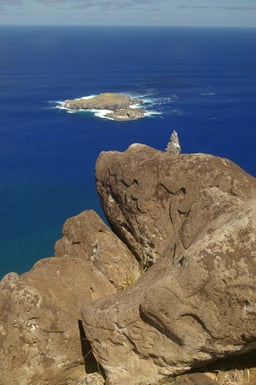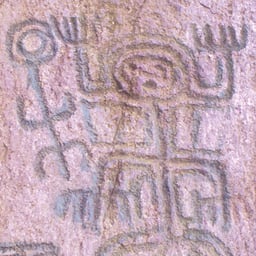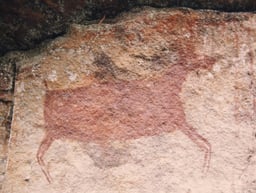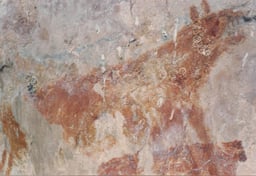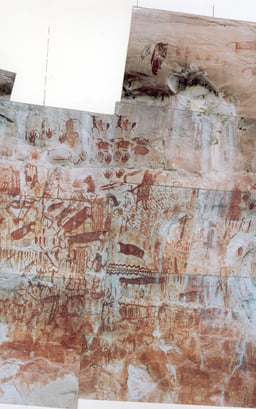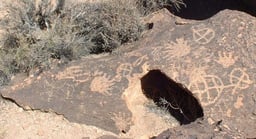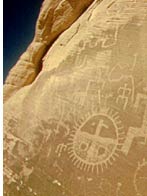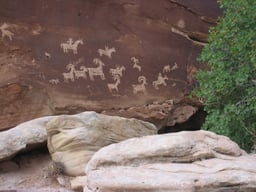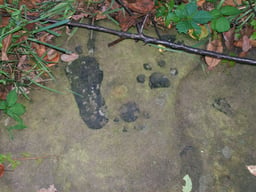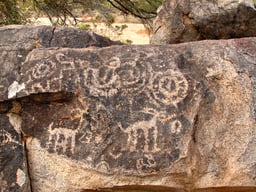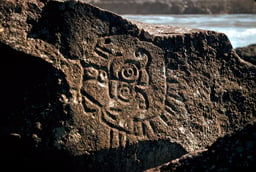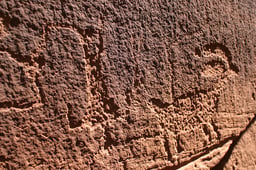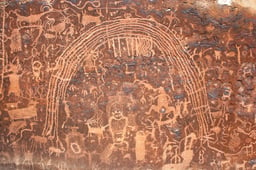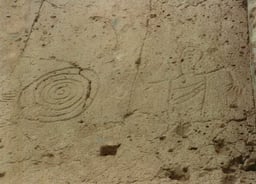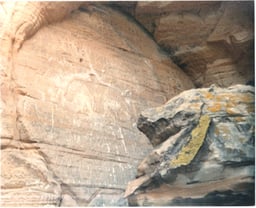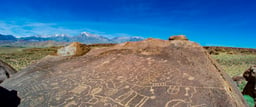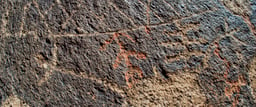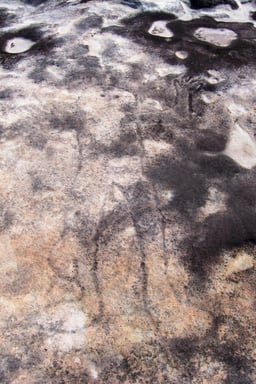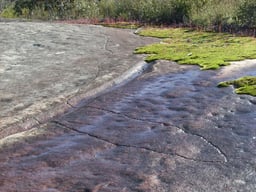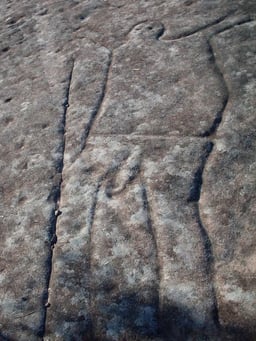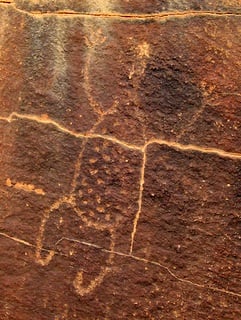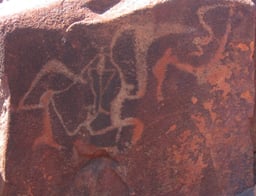Petroglyph
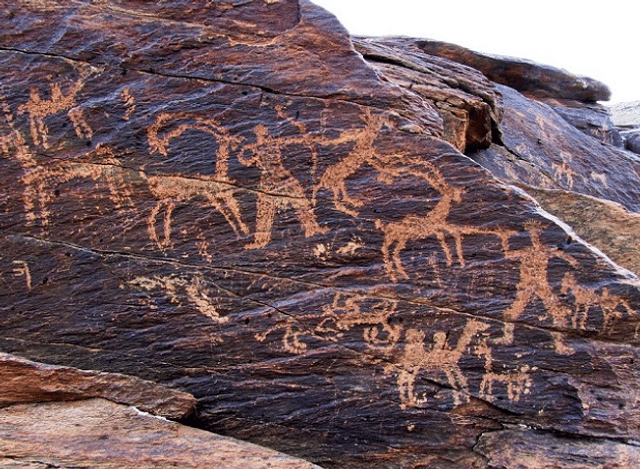
Petroglyph
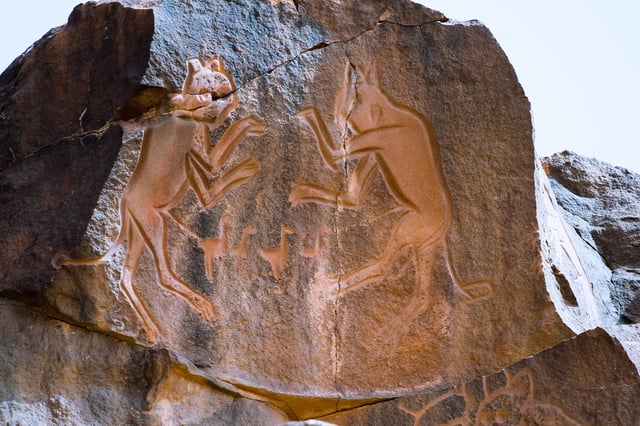
Rock carving known as Meerkatze (named by archaeologist Leo Frobenius), rampant lionesses in Wadi Mathendous, Mesak Settafet region of Libya.
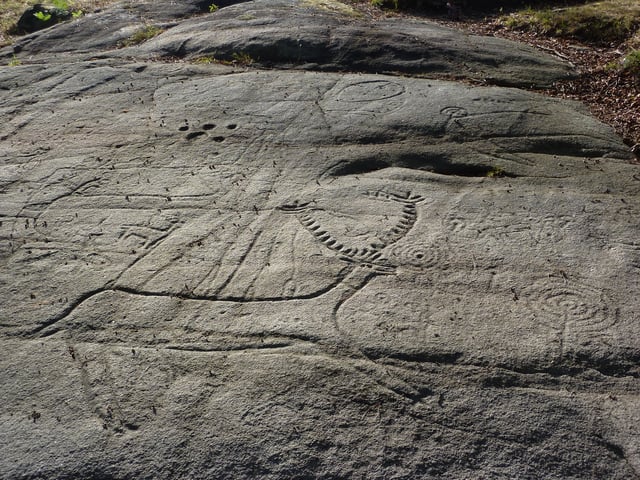
European petroglyphs: Laxe dos carballos in Campo Lameiro, Galicia, Spain (4th–2nd millennium BCE), depicting cup and ring marks and deer hunting scenes
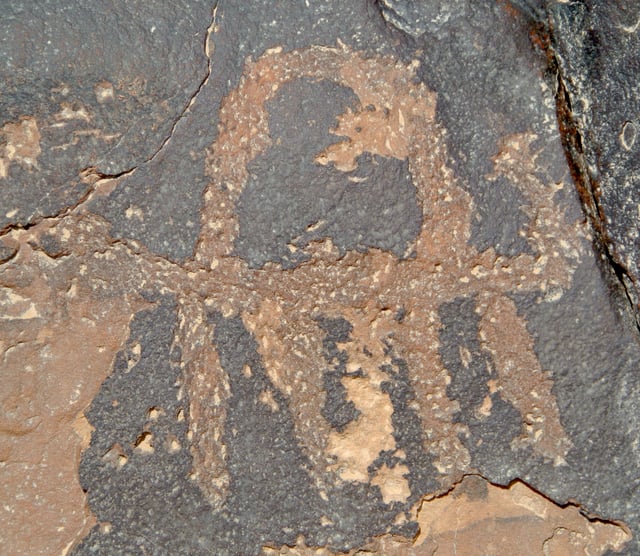
Petroglyph of a camel; Negev, southern Israel.
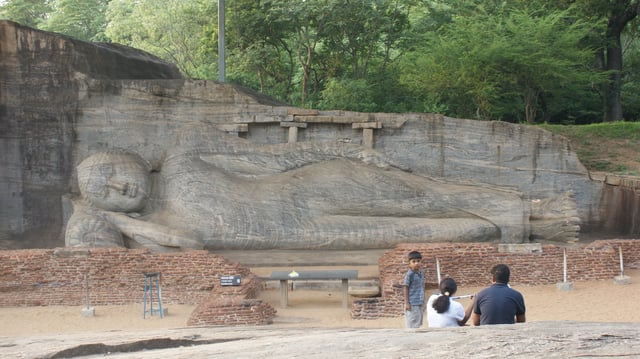
Reclining Buddha at Gal Vihara, Sri Lanka. The image house that originally enclosed the remains can be seen.
A petroglyph is an image created by removing part of a rock surface by incising, picking, carving, or abrading, as a form of rock art. Outside North America, scholars often use terms such as "carving", "engraving", or other descriptions of the technique to refer to such images. Petroglyphs are found worldwide, and are often associated with prehistoric peoples. The word comes from the Greek prefix petro-, from πέτρα petra meaning "stone", and γλύφω glýphō meaning "carve", and was originally coined in French as pétroglyphe.
Another form of petroglyph, normally found in literate cultures, a rock relief or rock-cut relief is a relief sculpture carved on "living rock" such as a cliff, rather than a detached piece of stone. While these relief carvings are a category of rock art, sometimes found in conjunction with rock-cut architecture,[1] they tend to be omitted in most works on rock art, which concentrate on engravings and paintings by prehistoric or nonliterate cultures. Some of these reliefs exploit the rock's natural properties to define an image. Rock reliefs have been made in many cultures, especially in the ancient Near East.[2] Rock reliefs are generally fairly large, as they need to be to make an impact in the open air. Most have figures that are larger than life-size.
Stylistically, a culture's rock relief carvings relate to other types of sculpture from period concerned. Except for Hittite and Persian examples, they are generally discussed as part of the culture's sculptural practice.[3] The vertical relief is most common, but reliefs on essentially horizontal surfaces are also found. The term relief typically excludes relief carvings inside natural or human-made caves, that are common in India. Natural rock formations made into statues or other sculpture in the round, most famously at the Great Sphinx of Giza, are also usually excluded. Reliefs on large boulders left in their natural location, like the Hittite İmamkullu relief, are likely to be included, but smaller boulders described as stele or carved orthostats.
The term petroglyph should not be confused with petrograph, which is an image drawn or painted on a rock face. Both types of image belong to the wider and more general category of rock art or parietal art. Petroforms, or patterns and shapes made by many large rocks and boulders over the ground, are also quite different. Inuksuit are also not petroglyphs, they are human-made rock forms found only in the Arctic region.
History
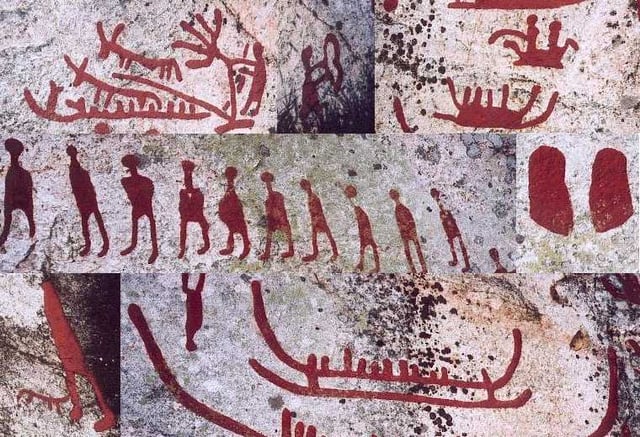
Composite image of petroglyphs from Scandinavia (Häljesta, Västmanland in Sweden). Nordic Bronze Age. The glyphs have been painted to make them more visible.
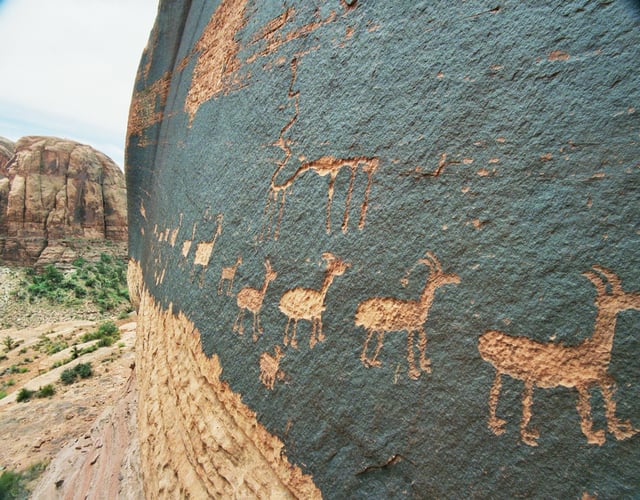
A petroglyph of a caravan of bighorn sheep near Moab, Utah, United States; a common theme in glyphs from the desert Southwest and Great Basin
Some petroglyphs might be as old as 40,000 years, and petroglyph sites in Australia are estimated to date back 27,000 years. Many petroglyphs are dated to approximately the Neolithic and late Upper Paleolithic boundary, about 10,000 to 12,000 years ago, if not earlier, such as Kamyana Mohyla. Around 7,000 to 9,000 years ago, other precursors of writing systems, such as pictographs and ideograms, began to appear. Petroglyphs were still common though, and some cultures continued using them much longer, even until contact with Western culture was made in the 19th and 20th centuries. Petroglyphs have been found in all parts of the globe except Antarctica, with highest concentrations in parts of Africa, Scandinavia, Siberia, southwestern North America, and Australia.
Interpretation
Many hypotheses explain the purpose of petroglyphs, depending on their location, age, and subject matter. Some many be astronomical markers, maps, and other forms of symbolic communication, including a form of proto-writing. Petroglyph maps may show trails, symbols communicating time and distances traveled, as well as the local terrain in the form of rivers, landforms, and other geographic features. A petroglyph that represents a landform or the surrounding terrain is known as a geocontourglyph. They might also have been a by-product of other rituals: sites in India, for example, have been identified as musical instruments or "rock gongs".[4]
Some petroglyph images probably have deep cultural and religious significance for the societies that created them; in many cases this significance remains for their descendants. Many petroglyphs are thought to represent some kind of not-yet-fully understood symbolic or ritual language. Later glyphs from the Nordic Bronze Age in Scandinavia seem to refer to some form of territorial boundary between tribes, in addition to possible religious meanings. Petroglyph styles has local or regional "dialects" from similar or neighboring peoples. Siberian inscriptions loosely resemble an early form of runes, although no direct relationship has been established. They are not yet well understood.
Petrogylphs from different continents show similarities. While people would be inspired by their direct surroundings, it is harder to explain the common styles. This could be mere coincidence, an indication that certain groups of people migrated widely from some initial common area, or indication of a common origin. In 1853, George Tate presented a paper to the Berwick Naturalists' Club, at which a John Collingwood Bruce agreed that the carvings had "... a common origin, and indicate a symbolic meaning, representing some popular thought."[5] In his cataloguing of Scottish rock art, Ronald Morris summarized 104 different theories on their interpretation.[6]
More controversial explanations of similarities are grounded in Jungian psychology and the views of Mircea Eliade. According to these theories it is possible that the similarity of petroglyphs (and other atavistic or archetypal symbols) from different cultures and continents is a result of the genetically inherited structure of the human brain.
Other theories suggest that petroglyphs were carved by spiritual leaders, such as shamans, in an altered state of consciousness,[7] perhaps induced by the use of natural hallucinogens. Many of the geometric patterns (known as form constants) which recur in petroglyphs and cave paintings have been shown by David Lewis-Williams to be hardwired into the human brain. They frequently occur in visual disturbances and hallucinations brought on by drugs, migraine, and other stimuli.
The Rock Art Research Institute (RARI) of the University of the Witwatersrand studies present-day links between religion and rock art among the San people of the Kalahari Desert.[10] Though the San people's artworks are predominantly paintings, the beliefs behind them can perhaps be used as a basis for understanding other types of rock art, including petroglyphs. To quote from the RARI website:
Using knowledge of San beliefs, researchers have shown that the art played a fundamental part in the religious lives of its painters. The art captured things from the San's world behind the rock-face: the other world inhabited by spirit creatures, to which dancers could travel in animal form, and where people of ecstasy could draw power and bring it back for healing, rain-making and capturing the game.[11]
List of petroglyph sites
Africa
Algeria
Tassili n'Ajjer
Cameroon
Bidzar
Central African Republic
Bambari, Lengo and Bangassou in the south; Bwale in the west
Toulou
Djebel Mela
Koumbala
Chad
Niola Doa
Republic of the Congo
The Niari Valley, 250 km south west of Brazzaville
Egypt
Wadi Hammamat in Qift, many carvings and inscriptions dating from before the earliest Egyptian Dynasties to the modern era, including the only painted petroglyph known from the Eastern Desert and drawings of Egyptian reed boats dated to 4000 BCE
Inscription Rock in South Sinai, is a large rock with carvings and writings ranging from Nabatean to Latin, Ancient Greek and Crusder eras located a few miles from the Ain Hudra Oasis. A second rock sites approximately 1 km from the main rock near the Nabatean tombs of Nawamis with carvings of animals including Camels, Gazelles and others. The original archaeologists who investigated these in the 1800s have also left their names carved on this rock.
Giraffe petroglyphs found in the region of Gebel el-Silsila. The rock faces have been used for extensive quarrying of materials for temple building especially during the period specified as the New Kingdom. The Giraffe depictions are located near a stela of the king Amenhotep IV. The images are not dated, but they are probably dated from the Predynastic periods.
Ethiopia
Tiya
Gabon
Ogooue River Valley
Epona
Elarmekora
Kongo Boumba
Lindili
Kaya Kaya
Libya
Akakus
Jebel Uweinat
Morocco
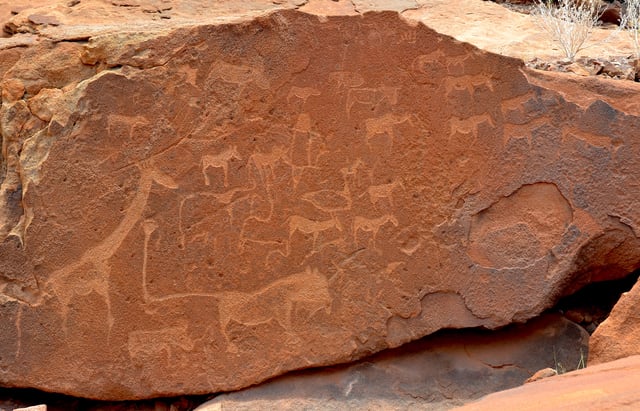
Lion Plate at Twyfelfontein in Namibia (2014)
The Draa River valley
Namibia
Twyfelfontein
Niger
Life-size giraffe carvings on Dabous Rock, Aïr Mountains
South Africa
Driekops Eiland near Kimberley[12]
ǀXam and ǂKhomani heartland in the Karoo, Northern Cape
Wildebeest Kuil Rock Art Centre near Kimberley, Northern Cape
Keiskie near Calvinia, Northern Cape
Zambia
Nyambwezi Falls in the north-west province.
Asia
Armenia
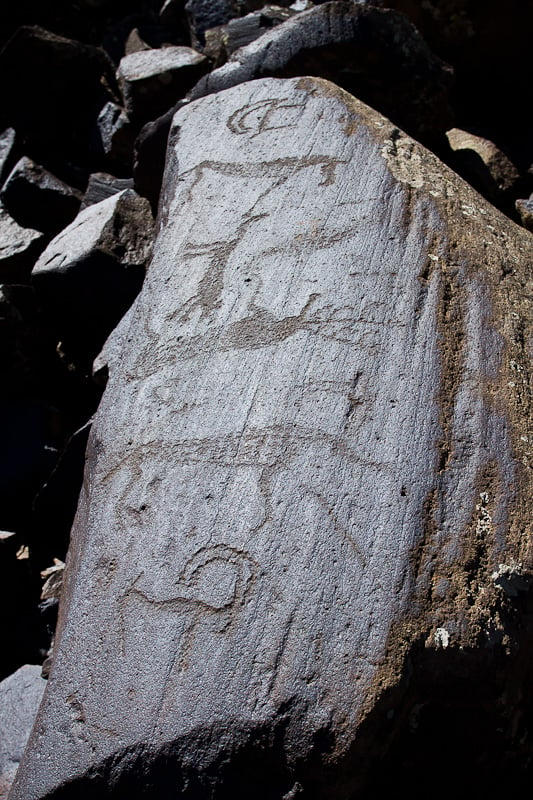
Petroglyphs at Ughtasar, Armenia
Ughtasar
Urtsadzor
Aragats[13]
See also Armenian Eternity sign
Azerbaijan
Gobustan State Reserve
China
Hong Kong
Eight sites in Hong Kong:
Tung Lung Island
Kau Sai Chau
Po Toi Island
Cheung Chau
Shek Pik on Lantau Island
Wong Chuk Hang and Big Wave Bay on Hong Kong Island
Lung Ha Wan in Sai Kung
India

Petroglyphs in Ladakh, India
Bhimbetka rock shelters, Raisen District, Madhya Pradesh, India.
Kupgal petroglyphs on Dolerite Dyke, near Bellary, Karnataka, India.
Kudopi, Sindhudurg District, Maharashtra, India.
Hiwale, Sindhudurg District, Maharashtra, India.
Barsu, Ratnagiri District, Maharashtra, India.
Devihasol, Ratnagiri District, Maharashtra, India
Edakkal Caves, Wayanad District, Kerala, India.
Perumukkal, Tindivanam District, Tamil Nadu, India.
Kollur, Villupuram, Tamil Nadu.
Unakoti near Kailashahar in North Tripura District, Tripura, India.
Usgalimal rock engravings, Kushavati river banks, in Goa[15]
Ladakh, NW Indian Himalaya.[16]
Recently petroglyphs were found at Kollur village in Tamil Nadu. A large dolmen with four petroglyphs that portray men with trident and a wheel with spokes has been found at Kollur near Triukoilur 35 km from Villupuram. The discovery was made by K.T. Gandhirajan. This is the second instance when a dolmen with petrographs has been found in Tamil Nadu, India.[17] In October 2018, petroglyphs were discovered in the Ratnagiri and Rajapur areas in the Konkan region of western Maharashtra. Those rock carvings which might date back to 10,000 BC, depict animals like hippopotamuses and rhinoceroses which aren't found in that region of India.[18]
Iran
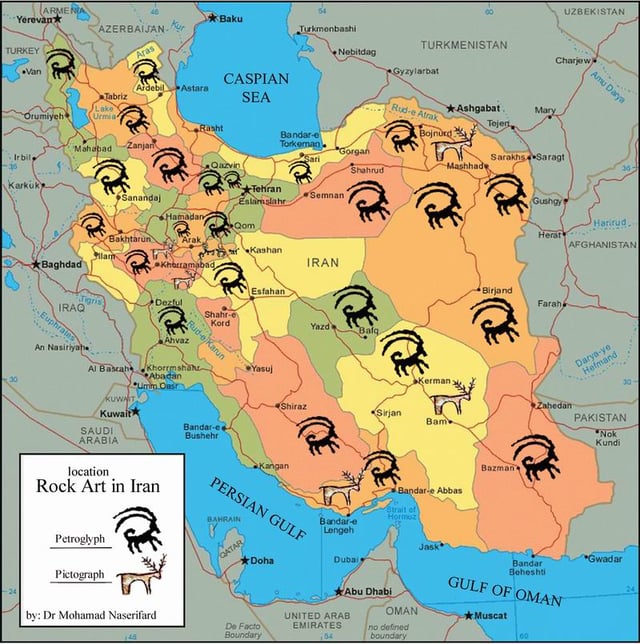
Map of petroglyphs and pictographs of Iran
During recent years a large number of rock carvings has been identified in different parts of Iran. The vast majority depict the ibex.[19][20] Rock drawings were found in December 2016 near Khomeyn, Iran, which may be the oldest drawings discovered, with one cluster possibly 40,000 years old. Accurate estimations were unavailable due to US sanctions.[21]
Petroglyphs are the most ancient works of art left by humankind that provide an opening to the past eras of life and help us to discover different aspects of prehistoric lives. Tools to create petroglyphs can be classified by the age and the historical era; they could be flint, thighbone of hunted quarries, or metallic tools. The oldest pictographs in Iran are seen in Yafteh cave in Lorestan that date back 40,000 and the oldest petroglyph discovered belongs to Timareh dating back to 40,800 years ago.
Iran provides demonstrations of script formation from pictogram, ideogram, linear (2300 BC) or proto Elamite, geometric old Elamite script, Pahlevi script, Arabic script (906 years ago), Kufi script, and Farsi script back to at least 250 years ago. More than 50000 petroglyphs have been discovered, extended over all Iran's states.[22]
Israel
Kibbutz Ginosar
Har Karkom
Negev
Japan
Jordan
Wadi Rum
Wadi Faynan
Kazakhstan
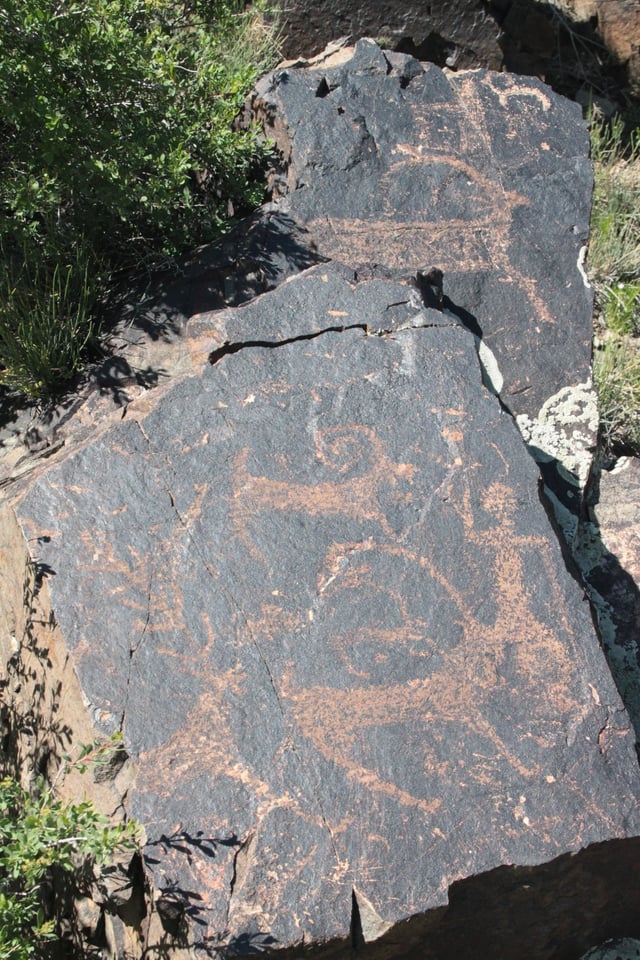
Hunting scene in Koksu petroglyphs
Koksu River, in Almaty Province
Chumysh River basin,
Tamgaly Tas on the Ili River
Tamgaly – a World Heritage Site nearly of Almaty
Laos
Plain of Jars
South Korea
Bangudae Petroglyphs
Kyrgyzstan
Several sites in the Tien Shan mountains: Cholpon-Ata, the Talas valley, Saimaluu Tash, and on the rock outcrop called Suleiman's Throne in Osh in the Fergana valley
Macau
Coloane
Malaysia
Lumuyu Petroglyphs
Pakistan
Ancient Rock Carvings of Sindh
Rock art and petroglyphs in Northern Areas,
Philippines
Angono Petroglyphs of Rizal, Philippines
Saudi Arabia
"Graffiti Rocks", about 110 km SW of Riyadh off the Mecca highway
Arwa, west of Riyadh
al Jawf, near al Jawf
Jubbah, Umm Samnan, north of Hail
Janin Cave, south of Hail
Yatib, south of Hail
Milihiya, south of Hail
Jebel al Lawz, north of Tabuk
Wadi Damm, near Tabuk
Wadi Abu Oud, near al Ula
Shuwaymis, north of Madina
Jebel al Manjour & Ratt, north of Madina
Hanakiya, north of Madina
Shimli
Bir Hima, north of Najran
Tathleeth, north of Najran
Al-Magar, in Najd
Taiwan
The Wanshan Rock Carvings Archeological Site near Maolin District, Kaohsiung, were discovered between 1978 and 2002.
Vietnam
Rock engravings in Sapa, Sa Pa, Lào Cai Province
Rock engravings in Namdan, Xín Mần District, Hà Giang Province
Europe
England
Boscawen-un, St Buryan
Cup and ring marked rocks in: Northumberland, County Durham, Ilkley Moor, Yorkshire, Gardom's Edge, Derbyshire, Creswell Crags, Nottingham
Finland
Hauensuoli, Hanko, Finland
France
Vallée des Merveilles, Mercantour National Park, France
Ireland
Newgrange
Knowth
Dowth
Loughcrew
Tara
Clonfinlough Stone
Boheh Stone
Italy
Rock Drawings in Valcamonica – World Heritage Site, Italy (biggest European site, over 350,000)
Bagnolo stele, Valcamonica, Italy
Grotta del Genovese, Sicily, Italy
Grotta dell'Addaura, Sicily, Italy
Rock Engravings in Grosio (in Valtellina), Italy
Northern Ireland
Knockmany
Sess Kilgreen
Norway
Rock carvings at Alta, World Heritage Site (1985)
Rock carvings in Central Norway
Rock carvings at Møllerstufossen
Rock carvings at Tennes
Portugal
Prehistoric Rock Art Sites in the Côa Valley, Portugal
Scotland
Museum of Ayrshire Country Life and Costume, North Ayrshire
Burghead Bull, Burghead
Townhead, Galloway[28]
Ballochmyle cup and ring marks
Spain
Petroglyphs from Galicia[29]
Russia
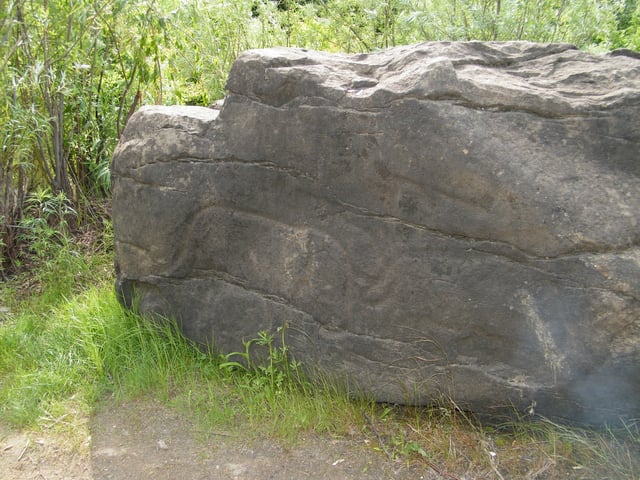
Mammoth on the basalt stone in Sikachi-Alyan, Russia
Petroglyph Park near Petrozavodsk–Lake Onega, Russia
Tomskaya Pisanitsa
Kanozero Petroglyphs
Sikachi-Alyan, Khabarovsk Krai
Kapova cave, Bashkortostan
Sweden
Tanumshede (Bohuslän); World Heritage Site (1994)
Himmelstalund (by Norrköping in Östergötland)
Enköping (Uppland)
Southwest Skåne (Götaland)
Alvhem (Västra Götaland)
Torhamn (Blekinge)
Nämforsen (Ångermanland)
Häljesta (Västmanland)
Slagsta (Södermanland)
Glösa (Jämtland)
The King's Grave at Kivik
Rock carvings at Norrfors, Umeå[30]
Släbro rock carvings in Nyköping (Södermanland)
Turkey
Kagizman, Kars
Cunni Cave, Erzurum
Esatli, Ordu
Gevaruk Valley, Hakkâri
Hakkari Trisin, Hakkâri
Latmos / Beşparmak
Güdül, Ankara
Ukraine
Kamyana Mohyla, Zaporizhia Oblast
Stone stelae of the Ukraine
Wales
Garn Turne, Pembrokeshire
Central and South America and the Caribbean
Argentina
Cueva de las Manos, Santa Cruz
Talampaya National Park, La Rioja
Lihué Calel National Park, La Pampa
Aruba
Arikok National Park
Quadiriki Caves
Ayo and Casabari Rock Formations
Brazil
The oldest reliably dated rock art in the Americas is known as the "Horny Little Man." It is petroglyph depicting a stick figure with an oversized phallus and carved in Lapa do Santo, a cave in central-eastern Brazil and dates from 12,000 to 9,000 years ago.[31]
Serra da Capivara National Park, a UNESCO World Heritage Site, Piauí
Vale do Catimbau National Park, Pernambuco
Ingá Stone, Paraíba
Costao do Santinho, Santa Catarina
Lagoa Santa (Holy Lake), Minas Gerais
Ivolandia, Goiás
Chile
Rincón las Chilcas, Combarbalá
Easter Island petroglyphs
Colombia
El Abra, Cundinamarca
Chiribiquete Natural National Park
Costa Rica
Rincon de la Vieja, Guanacaste
Dominican Republic
Cueva de las Maravillas, San Pedro de Macorís
Las Caritas, near Lake Enriquillo
Los Tres Ojos, Santo Domingo
Grenada
Mt. Rich Petroglyphs
Paraguay

Fertility symbols, called "Ita Letra" by the local Panambi'y people, in a natural shelter in Amambay, Paraguay
Amambay Department
Peru
Cumbe Mayo, Cajamarca
Petroglyphs of Pusharo, Manú National Park, Madre de Dios region
Petroglyphs of Quiaca, Puno Region
Petroglyphs of Jinkiori, Cusco Region
Puerto Rico
La Piedra Escrita (The Written Rock), Jayuya
Caguana Indian Park, Utuado
Tibes Indian Park, Ponce
La Cueva del Indio (Indians Cave), Arecibo
Saint Kitts and Nevis
Carib Petroglyphs, Wingfield Manor Estate, Saint Kitts
Suriname
Corantijn Basin
Trinidad and Tobago
Caurita[[INLINE_IMAGE|//upload.wikimedia.org/wikipedia/commons/thumb/a/a8/Caurita_Petroglyph.jpg/220px-Caurita_Petroglyph.jpg|//upload.wikimedia.org/wikipedia/commons/thumb/a/a8/Caurita_Petroglyph.jpg/330px-Caurita_Petroglyph.jpg 1.5x, //upload.wikimedia.org/wikipedia/commons/thumb/a/a8/Caurita_Petroglyph.jpg/440px-Caurita_Petroglyph.jpg 2x||h165|w220|thumbimage]] The only known Amerindian petroglyph in Trinidad
Venezuela
Caicara del Orinoco, Bolívar
North America
Canada
Kejimkujik National Park, Nova Scotia
Petroglyph Provincial Park, Nanaimo, British Columbia[36]
Petroglyphs Provincial Park, north of Peterborough, Ontario
Agnes Lake, Quetico Provincial Park, Ontario
Sproat Lake Provincial Park, near Port Alberni, British Columbia
Stuart Lake, British Columbia
St. Victor Provincial Park, Saskatchewan
Writing-on-Stone Provincial Park, east of Milk River, Alberta
Gabriola Island, British Columbia[37]
East Sooke Regional Park, British Columbia
Ancient Echoes Interpretive Centre [49] , Herschel Saskatchewan
Mexico
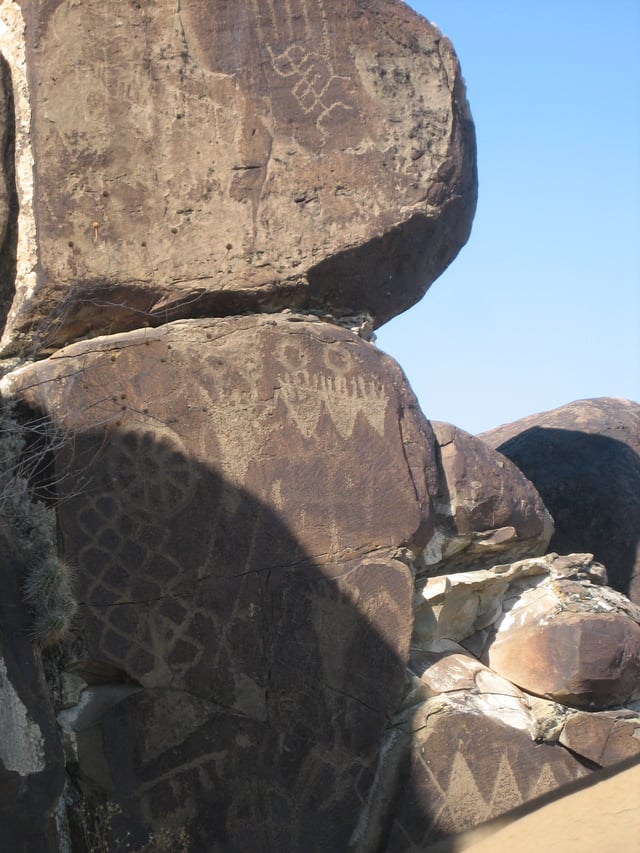
Near Parras, Coahuila
Boca de Potrerillos, Mina, Nuevo León
Chiquihuitillos, Mina, Nuevo León
Cuenca del Río Victoria, near Xichú, Guanajuato
Coahuiltecan Cueva Ahumada, Nuevo León
La Proveedora, Caborca, Sonora
Samalayuca, Juarez, Chihuahua
Las Labradas, near Mazatlán, Sinaloa
United States
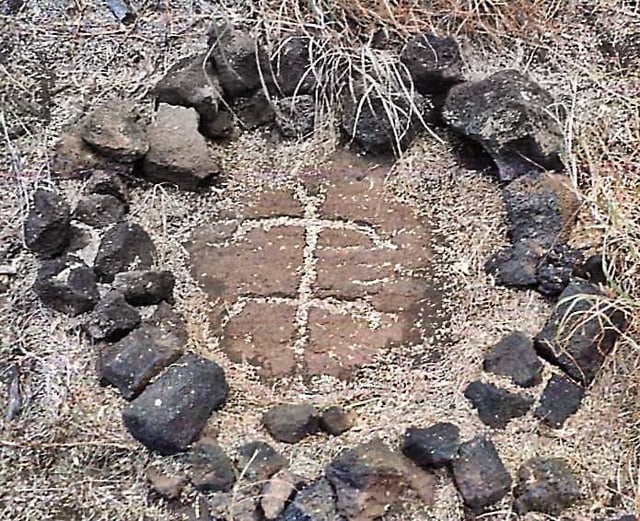
Petroglyph on western coast of Hawaii
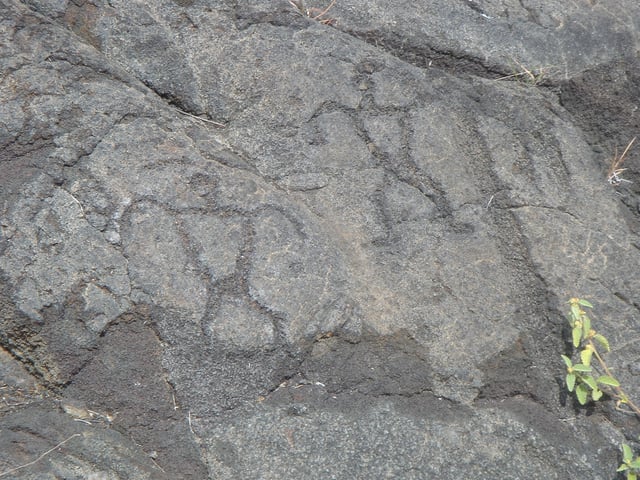
Hawai'i Volcanoes National Park
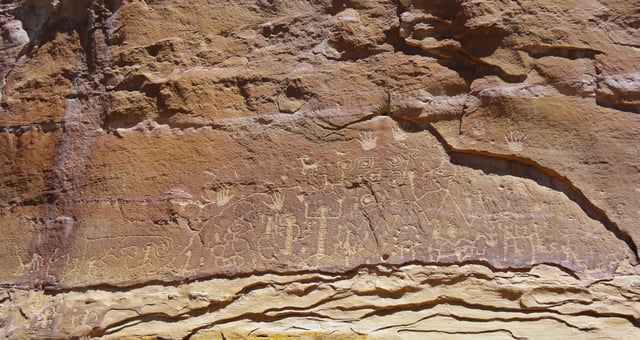
Modern Hopi have interpreted the petroglyphs at Mesa Verde National Park's Petroglyph Point as depictions of the Eagle, Mountain Sheep, Parrot, Horned Toad, and Mountain Lion clans, and the Ancestral Puebloans who inhabited the mesa
Arches National Park, Utah
Bandelier National Monument, New Mexico
Barnesville Petroglyph, Ohio
Bloomington Petroglyph Park, Utah [50]
California Petroglyphs & Pictographs[38]
Capitol Reef National Park, Utah
Columbia Hills State Park, Washington[39]
Corn Springs, Colorado Desert, California
Coso Rock Art District, Coso Range, northern Mojave Desert, California[40]
Death Valley National Park, California
Dinosaur National Monument, Colorado and Utah
Dighton Rock, Massachusetts
Dominguez Canyon Wilderness, Colorado
Fremont Indian State Park Utah
Grand Traverse Bay Michigan
Great Basin National Park Nevada
Grimes Point, Nevada[41]
Independence Slab, Ohio
Inscription Rock (Kelleys Island, Ohio), Ohio
Jeffers Petroglyphs, Minnesota
Judaculla Rock, North Carolina
Kanopolis State Park, Kansas
Lava Beds National Monument, Tule Lake, California
Legend Rock Petroglyph Site, Thermopolis, Wyoming
Lemonweir Glyphs, Wisconsin
Mesa Verde National Park, Colorado
Newspaper Rock State Historic Monument, Utah
Olympic National Park, Washington
Paintlick Mountain, Tazewell, Virginia[43]
Petit Jean State Park, Arkansas
Petrified Forest National Park Arizona
Petroglyph National Monument, New Mexico[44]
Picture Canyon, Flagstaff, Arizona
Puye Cliff Dwellings, New Mexico
Red Rock Canyon National Conservation Area, Nevada
Rochester Rock Art Panel, Utah
Ring Mountain, Marin County, California
Saint John, U.S. Virgin Islands
Sanilac Petroglyphs Historic State Park, Michigan
Sedona, Arizona
Seminole Canyon, Texas
Sloan Canyon National Conservation Area, Nevada
South Mountain Park, Arizona
The Cove Palisades State Park, Oregon
Three Rivers Petroglyphs, New Mexico[45]
Valley of Fire State Park, Nevada
Washington State Park, Washington County, Missouri
West Virginia glyphs
White Mountain (Wyoming), Rock Springs, Wyoming
White Tank Mountain Regional Park, Waddell, Arizona
Winnemucca Lake, Nevada
Writing Rock State Historical Site, North Dakota
Monolyth at Caguas & El Yunque, Puerto Rico
Track Rock, Georgia
Forsyth Petroglyph Originally discovered, locates and documented near Cumming, Georgia in Forsyth County but has been relocated to the campus of the University of Georgia in Athens, Georgia
Oceania
Australia
Arnhem Land / Kakadu National Park, Northern Australia
Murujuga, Western Australia – world heritage assessed
Sydney Rock Engravings, New South Wales
See also
Geoglyph
History of communication
List of Stone Age art
Megalithic art
Pecked curvilinear nucleated
Petrosomatoglyph
Runestone and image stone
Water glyphs
